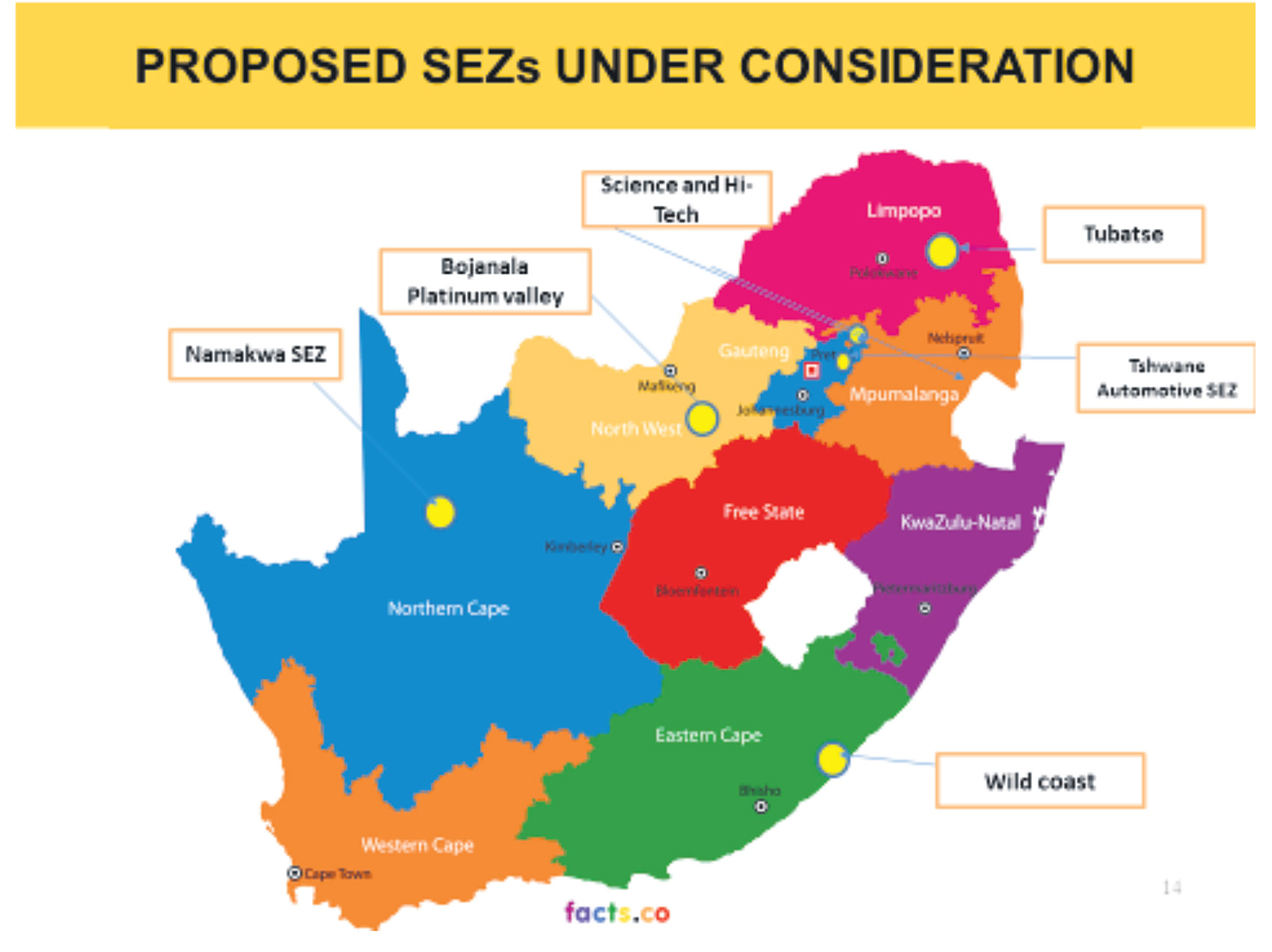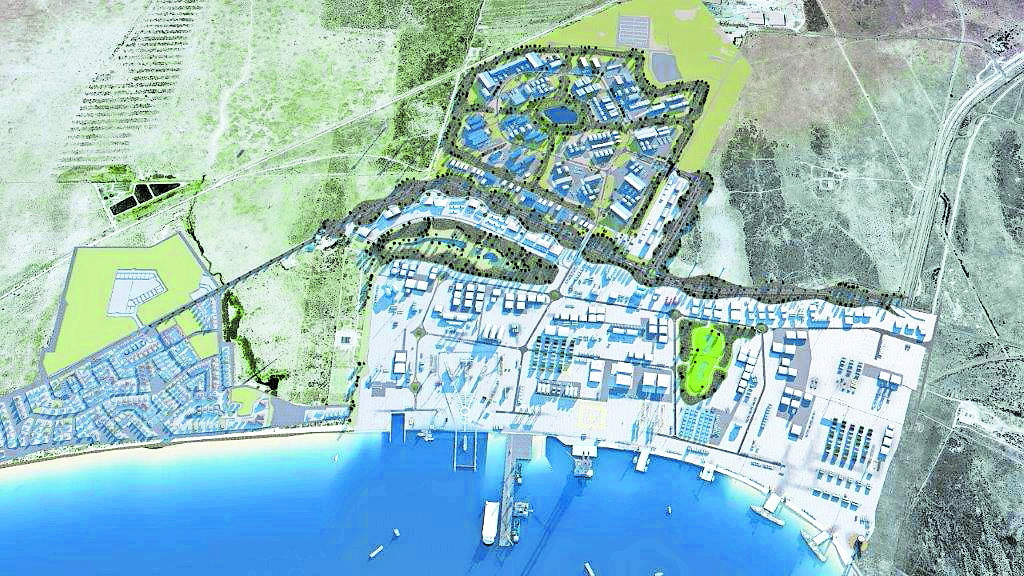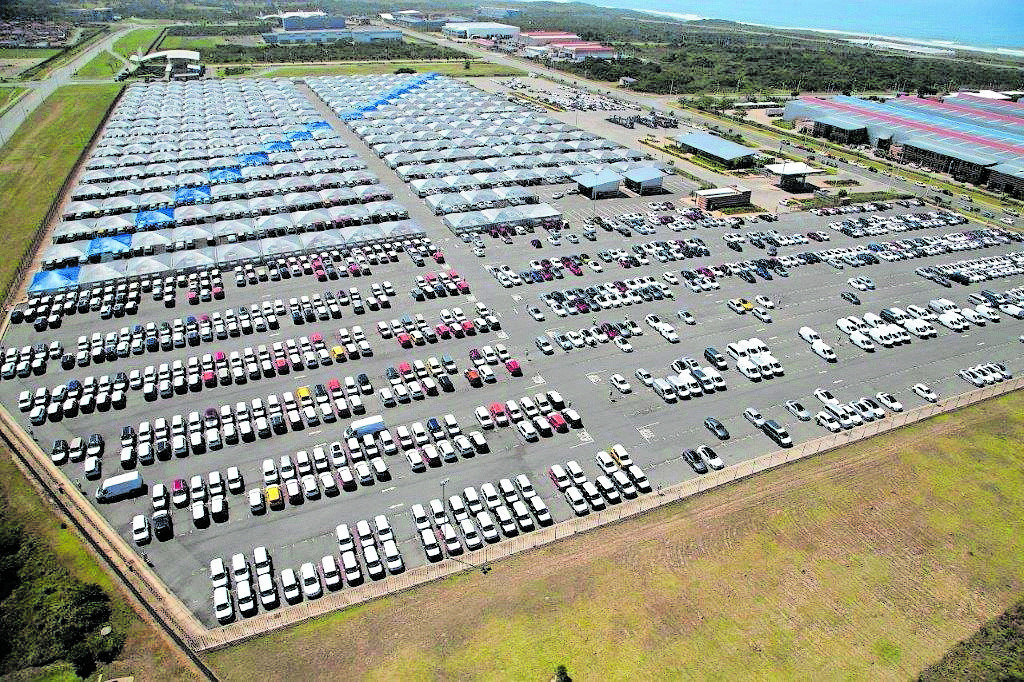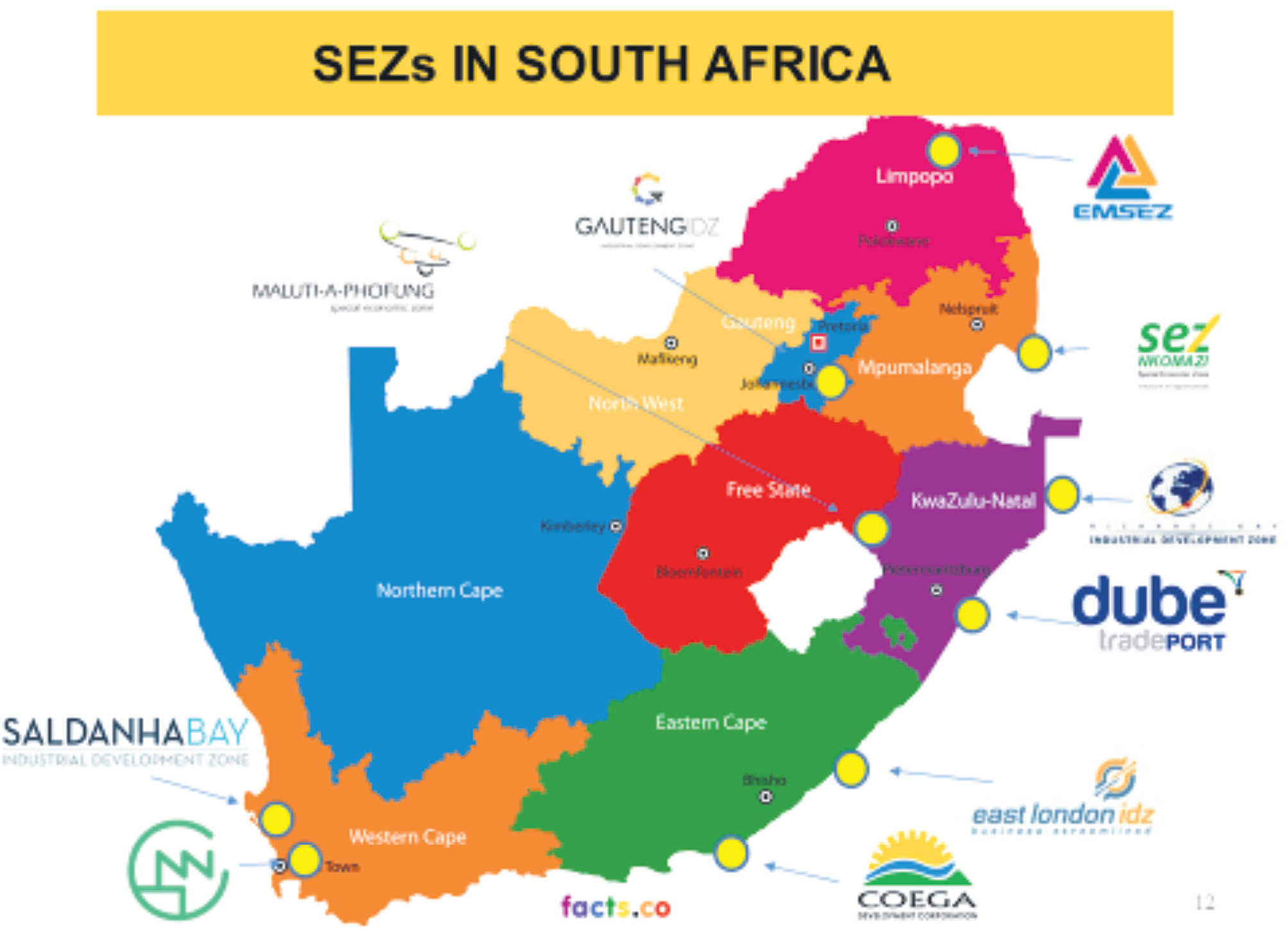Dube TradePort is the only facility in Africa that brings together an international airport, cargo terminal, warehousing, offices, retail sector, hotels and agricultural area.
One of the critical tools for accelerating the country’s industrial development agenda is the new Special Economic Zone (SEZ) Programme, which was mandated by the SEZ Act, proclaimed in February, 9, 2016. SEZs are a tool to help:
(i) promote industrial agglomeration;
(ii) build the required industrial infrastructure;
(iii) promote co-ordinated planning among key government agencies and the private sector; and
(iv) guide the deployment of other necessary development tools.

Background
The majority of economically successful countries across the globe have used industrialisation as the preferred route towards sustainable economic development. South Africa’s industrial development agenda is informed by a realisation that industrial development offers the most sustainable route towards economic prosperity and success. This is clearly articulated in our National Industrial Policy Framework (NIPF), Industrial Policy Action Plan (IPAP) and National Development Plan (NDP). These important policy and strategy documents outline a number of challenges confronting the country’s economy, goals and key drivers, cross-cutting measures as well as sector-specific measures that are critical to drive the country’s industrial and economic agenda.
More importantly, the implementation of the country’s industrial development agenda requires adaptable, effective and efficient instruments that are responsive to the strategic needs of the host region, investors and other strategic stakeholders. To this end, the government has developed Special Economic Zone (SEZ) policy and legislation (Special Economic Zone Act No. 16 of 2014) as one of the key instruments to accelerate the implementation of its industrialisation agenda. The programme has been designed to attract foreign and domestic direct investments to the designated zones and host regions; expand the manufacturing sector as a critical foundation to grow both the primary and secondary economic activities in the economy; grow and diversify value-added exports; create sustainable and decent jobs in the host regions; and enhance innovation, attraction, development and retention of talent and knowledge.

SEZs are extremely useful to investors as they receive tax and financial incentives that are not available to investors outside designated zones. They also provide investors with better economic threshold with respect to a balanced social and economic infrastructure, as well as transport and logistics networks. Communities in regions hosting SEZs also benefit significantly from the private and public sector investments, which often results in earnings above national average, higher standards of living, increased employment, and reduced poverty and inequality. In addition, SEZs tend to attract special managerial and technical talent from around the world into the host regions. This facilitates the transfer of skills to the citizens of the host regions. Small, medium and micro enterprises in the host regions can also easily be integrated into the value chains developed through and in the zones.
The Special Economic Zones Programme is increasingly becoming the main driver of foreign direct investment in South Africa. At the moment, operational investments in all SEZs amounts to just over R19-billion, while secured but not yet operational investments amount to R43-billion (excluding the R40-billion for the Energy and Metallurgical Zone in Musina).

A summary of the performance of the zones
Despite the depressed global economic climate, the designated SEZs have shown impressive progress in terms of the number of investors operating in the zones. More importantly, there has also been a significant increase in the number and value of secured but not operational investments. Between Q1 of the 2018/19 and Q1 of the 2019/20 financial years, the number of operational investors in designated SEZs has increased from 110 to 122, with an investment value sitting at over R19-billion. The number of direct jobs has also increased from 13 466 to 15 737. The number of signed but non-operational investors is currently estimated to be 61, with a total investment value of R33.64-billion.
Among all SEZs, Coega SEZ continues to play a leading role as the country’s leading SEZ in terms of key corporate performance indicators. In the FY2018/19, Coega SEZ currently has 45 operational investors worth a combined investment value of R11.579-billion. The Dube TradePort in KZN has 35 operational investors with a value of R1.8-billion, with 3 331 direct jobs created. The SEZ boasts a pipeline of 36 investments with an estimated value of R10.2-billion. This includes MaraPhone, which is a R1.3-billion investment that will provide an estimated 1 500 jobs over five years. Saldanha Bay in the Western Cape, which will focus on the oil and gas industry, has 12 signed leased agreements, which total to an investment size of just over R3-billion. Five of these investors include joint investment projects between South African and international investors from the United Kingdom, Europe, the Middle East and Africa, with the rest being 100% local South African projects.
Additionally, due to the support provided by government, the newly approved SEZs have also attracted a significant number of secured but not yet operational investments. The below table shows the number of signed investors that are currently in different stages of development. Some of the 19 investors are already building infrastructure on the ground.

South Africa’s Special Economic Zones
Coega SEZ (Eastern Cape)
The Coega IDZ is the largest in Southern Africa. It was designated in 2001 and became South Africa’s first IDZ. It is strategically located in the Nelson Mandela Bay Metropolitan Municipality on the East-West trade route, to service both world and African markets. The Coega IDZ leverages public-sector investment to attract foreign and domestic direct investment in the manufacturing sector, with an export orientation. The IDZ has attracted investment in the agro-processing, automotive, aquaculture, energy, metals logistics and business process services sectors. This has advanced socioeconomic development in the Eastern Cape through skills development, technology transfer and job creation.
Richards Bay SEZ (KwaZulu-Natal)
The Richards Bay IDZ is a purpose-built and secure industrial estate on the north-eastern South African coast. The N2 business corridor links the province’s two major ports, Durban and Richards Bay, connects with Maputo in Mozambique and, ultimately, areas of east Africa. It is linked to the international sea port of Richards Bay, tailored for the manufacturing and storage of minerals and products to boost beneficiation, investment, economic growth and, most importantly, the development of skills and employment. First-world infrastructure allows for full exploitation of the area’s natural and strategic advantages. Through the superb industrial infrastructure, well-established network of shipments, and tax- and duty-free incentives, the IDZ aims to encourage international competitiveness and attract export-orientated manufacturing investment.
East London SEZ (Eastern Cape)
Innovation, efficiency, growth and sustainability are key to the East London IDZ (ELIDZ). Established in 2003, as part of the South African Government initiative to improve industrial competitiveness and economic growth in the country, the zone has become a prime industrial park, renowned for its customised solutions for various industries, including automotive, agro-processing and aquaculture. The ELIDZ offers growth-oriented companies a specialised manufacturing platform, innovative industrial and business solutions, and access to new markets and strategic industry networks.
The ELIDZ is located in Buffalo City, the municipal area that incorporates Bhisho, the province’s capital, and King William’s Town. It is one of the first IDZs in South Africa to be operational and is an ideal choice for the location of exported manufacturing and processing, providing investors with connections to major markets, locally and across the globe.
Saldanha Bay SEZ (Western Cape)
President Jacob Zuma launched the Saldanha Bay IDZ (SBIDZ) in the Western Cape in October 2013 and handed over the operator permit. It is envisioned that this IDZ will serve as the primary oil, gas and marine repair engineering and logistics services complex in Africa, servicing the needs of the upstream oil exploration industry and production service companies operating in the oil and gas fields off sub-Saharan Africa. Situated approximately two hours north of Cape Town, the SBIDZ will include logistics, repairs and maintenance, and fabrication activities.
Dube Tradeport SEZ (KwaZulu-Natal)
Dube TradePort is a catalyst for global trade and a portal between KwaZulu-Natal and the world. It is the only facility in Africa that brings together an international airport, cargo terminal, warehousing, offices, retail sector, hotels and agricultural area. Located 30km north of Durban, Dube TradePort is positioned between the two biggest sea ports of Southern Africa, and is linked to the rest of Africa by road and rail.
Areas that have been designated as the IDZ are the Dube TradeZone and the Dube AgriZone
The Dube TradeZone focuses on manufacturing and value-addition primarily for automotive, electronics and fashion garments. The facility involves warehousing, manufacturing, assembling real estate resources, complete with a single facility in which all freight-forwarders and shippers are located (Dube TradeHouse), which enjoys a direct link to the adjacent Dube Cargo Terminal via an elevated cargo conveyor system.
The Dube AgriZone is a high-tech, future-farming facility that hosts the continent’s largest climate-controlled growing area under glass and focuses on high-value, niche agricultural and horticultural products. The AgriLab researches specialised tissue culture, greenhouses, and flowers and plants, all of which require swift air transportation.
Maluti-A-Phofung SEZ (Free State)
Maluti-A-Phofung SEZ in Harrismith, Free State, lies at the mid-point of the crucial Durban-Johannesburg logistics route. This newly established SEZ offers exporters a logistics base that facilitates access to the Port of Durban, and intermodal logistics solutions for the transfer of freight between road and rail. The zone is well-suited and licensed for general manufacturing, offering a convenient production base for light and medium manufacturing. With excellent logistics links by road or rail to South Africa’s industrial heartland, the Port of Durban and the southern Bloemfontein-Cape Town route, the SEZ is a natural choice for investors seeking a cost-effective location to service domestic and export markets.
In addition, the SEZ intends building on existing strengths to attract agro-processing industries to an area that has good access to the products of the agriculturally rich Free State. It harbours intentions of acting as an agglomeration, storage and logistics point for agricultural produce. Owned by the Free State Development Corporation, this site has existing facilities that can be leased immediately, and is currently upgrading both the internal road and utility infrastructure to meet expected demand.
OR Tambo IDZ (Gauteng)
The OR Tambo IDZ aims to develop land around OR Tambo International Airport to stimulate economic development through the use of the IDZ mechanism. The OR Tambo IDZ supports the growth of the beneficiation of precious metals and minerals sector, with a focus on light, high-margin, export-oriented manufacturing of South African precious and semiprecious stones. The multi-site development at OR Tambo IDZ consists of several industry-specific precincts and will be developed in phases over a 10- to 15-year period.
Musina/Makhado SEZ (Limpopo)
The Musina/Makhado SEZ comprises two geographical locations that address unique industrial clusters. The site in Musina targets the light industrial and agro-processing clusters, while the Makhado site is a metallurgical/mineral beneficiation complex. A third site has been identified to target the petrochemical industries.
The SEZ is strategically located along the N1 north-south route into the Southern African Development Community (SADC), very close to the border between South Africa and Zimbabwe. It forms part of the Trans-Limpopo Spatial Development Initiative and has been developed as part of greater regional plans to unlock investment and economic growth, and to address the development of skills and employment. Newly built infrastructure enables full utilisation of the area’s unique combination of mineral endowments and supports industries in the full-value chains for mineral beneficiation, agro-processing and light industrial manufacturing.
The strategic location of the SEZ and its close proximity to the main land-based route into SADC and the African continent, together with supporting incentives and a good logistics backbone, will make it the location of choice for investment in the mineral beneficiation, agro-processing and petrochemical industries.
Atlantis SEZ (Western Cape)
The Atlantis SEZ is part of the City of Cape Town’s initiative taken in 2011 to establish a greentech manufacturing hub in Atlantis.
Situated on the West Coast of South Africa, 40km from Cape Town, the Atlantis SEZ (ASEZ) capitalises on the province’s already booming renewable energy and green technology sector. The hub has already attracted its first large greentech investor, Gestamp Renewable Industries (GRI). A wind tower manufacturer, GRI has already invested and is in full-scale production.

Nkomazi SEZ (Mpumulanga)
The Nkomazi SEZ is located in the Nkomazi local municipality in the eastern part of Ehlanzeni district municipality of the Mpumalanga province. The sector that the Nkomazi SEZ is focusing on is agro-processing and logistics, with the objective to provide support for the establishment of a range of logistic support infrastructure for transport, warehousing facilities, agro-processing and logistics facilities, automotive and the mining and mineral industries of South Africa.
2. SEZ tax incentives
To complement the department of trade and industry’s SEZ strategy, a package of tax incentives will be available to companies locating in certain SEZs, subject to specific criteria. The tax incentives that companies may qualify for include VAT and customs relief if located within a Customs-Controlled Area (CCA), an employment tax incentive, a building allowance and reduced corporate income tax rate.
The design and eligibility criteria for each incentive seeks to strike a balance between achieving the objectives of higher levels of investment, growth and employment creation, and ensuring that the incentives are appropriately targeted for efficiency purposes, while minimising any deadweight loss to the fiscus.
Business located within a CCA will qualify for VAT and customs relief (similar to that for the current IDZs). The employment tax incentive will be available to businesses located in any SEZ. Businesses operating within approved SEZs (by the minister of finance, after consultation with the minister of trade and industry) will be eligible for two additional tax incentives. Firstly, all such businesses can claim accelerated depreciation allowances on capital structures (buildings) and, secondly, certain companies (carrying on qualifying activities within an approved SEZ) will benefit from a reduced corporate tax rate (15% instead of 28%).
VAT and customs relief
Companies located within a CCA will be eligible for VAT and customs relief, as per the current IDZs.
Characteristics of a CCA include the following:
Import duty rebate and VAT exemption on imports of production-related raw materials, including machinery and assets, to be used in production with the aim of exporting the finished products;
VAT suspension under specific conditions for supplies procured in South Africa; and
Efficient and expedited customs administration.
More information on CCAs can be found on the SARS website www.sars.gov.za
Employment tax incentive
All employers of low-salaried employees (below R60 000 per annum) in any SEZ will be entitled to the employment tax incentive (ETI). This is to encourage employers to hire young and less experienced work seekers. However, the employee age restriction will not apply to SEZs. It reduces an employer’s cost of hiring people through a cost-sharing mechanism with government, while leaving the wage the employee receives unaffected. The employer can claim the ETI and reduce the amount of Pay-As-You-Earn (PAYE) tax payable by the amount of the total ETI calculated in respect of all qualifying employees.
Building allowance
Businesses operating within approved SEZs (after approval by the minister of finance, after consultation with the minister of trade and industry) will be eligible for an accelerated depreciation allowance on capital structures (buildings). The special rate of capital (depreciation) allowances in lieu of normal allowances will be available for erecting or improving buildings and other fixed structures. This rate will equal 10% per annum over 10 years.
Reduced corporate income tax rate
Certain companies will qualify for a reduced corporate income tax rate of 15%, instead of the current 28% headline rate. To qualify, the following conditions must be satisfied:
The company must be located in a SEZ that is approved by the minister of finance;
It must be incorporated or effectively managed in South Africa;
At least 90% of the income must be derived from the carrying on of business or provision of services within that SEZ; and
The company must not be engaging in activities listed in the Government Gazette No. 39930.
New SEZs
In addition to the approved list of Special Economic Zones, the department of trade and industry continues to plan for the new SEZs in other provinces with a view to expand the industrialisation in South Africa. The new proposed SEZs include Bojanala SEZ in North West and Namakwa SEZ in Northern Cape, Science and High-Tech and Automotive SEZs in Gauteng, Tubatse SEZ in Limpopo as well as Wild Coast SEZ in the Eastern Cape. The below map depicts the list of proposed SEZs that are currently underway.
Conclusion
The current work package on Special Economic Zones in centred around the full implementation of the programme. But more importantly, the focus is on investment promotion and marketing of SEZs, building of critical infrastructure, institutional development and capacity building of municipalities and provinces, planning and designation of new SEZs, stakeholder mobilisation and management as well as continuous improvements of policies and strategies.